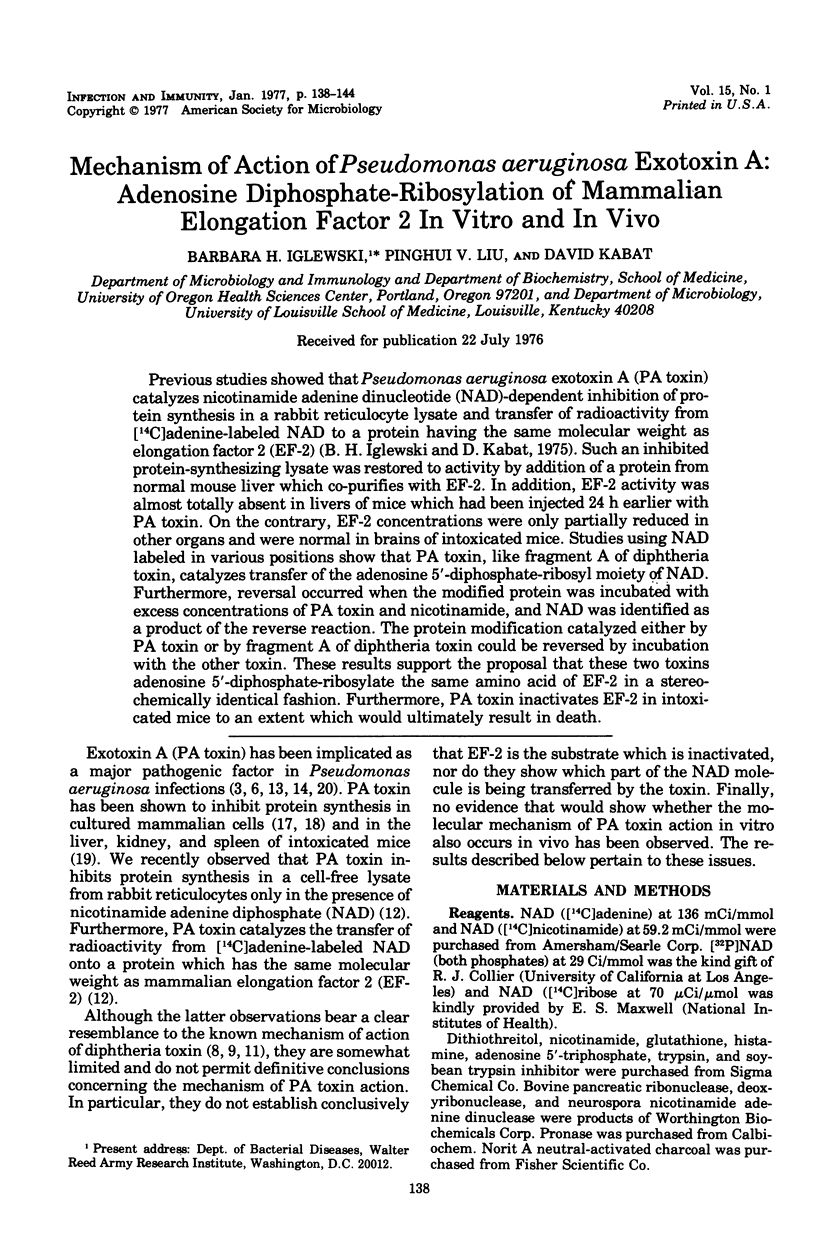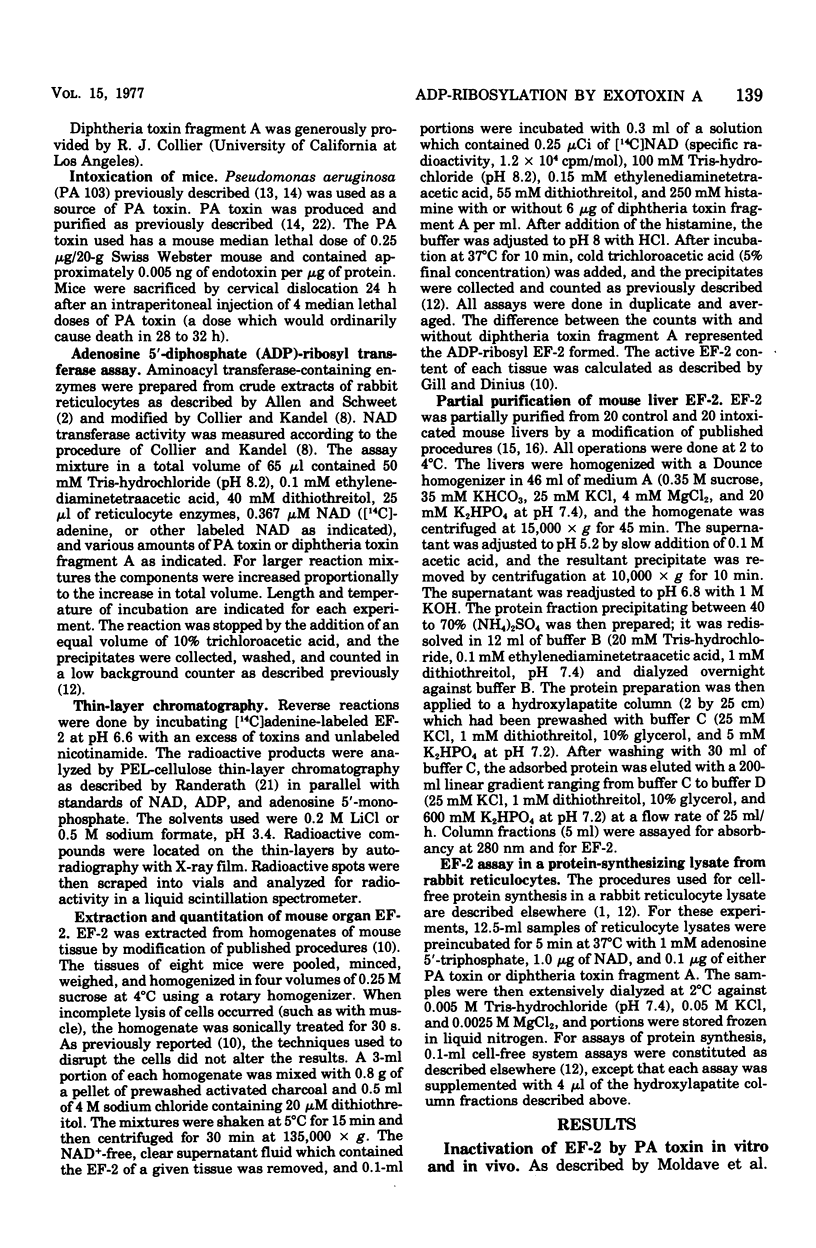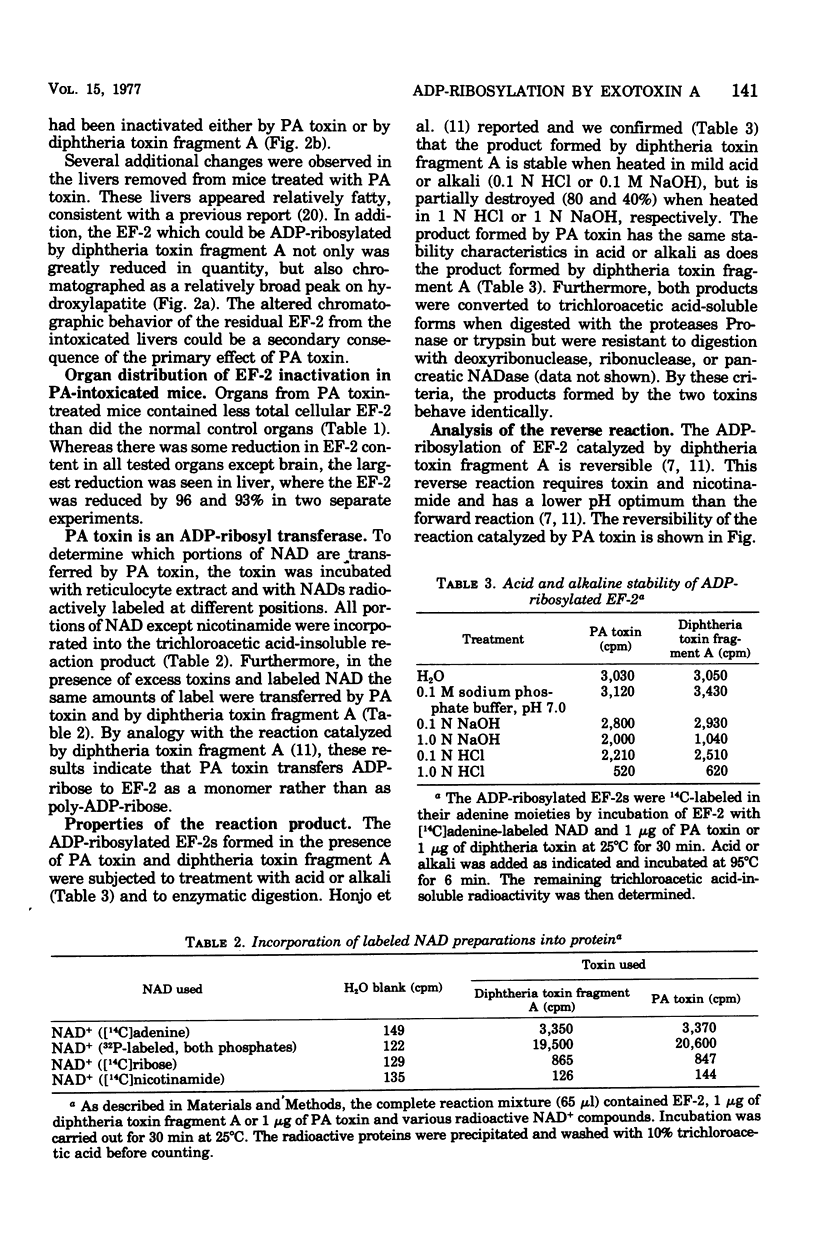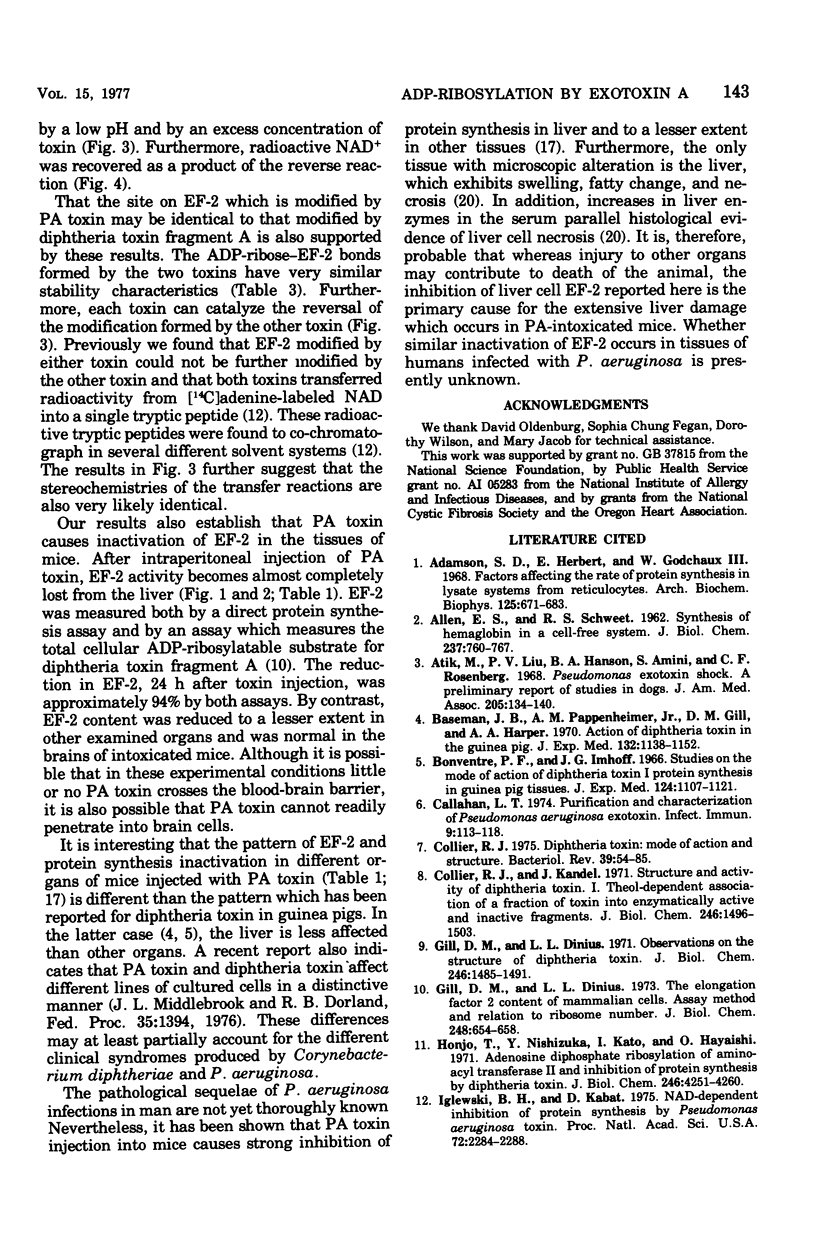Abstract
Previous studies showed that Pseudomonas aeruginosa exotoxin A (PA toxin) catalyzes nicotinamide adenine dinucleotide (NAD)-dependent inhibition of protein synthesis in a rabbit reticulocyte lysate and transfer of radioactivity from [14C]adenine-labeled NAD to a protein having the same molecular weight as elongation factor 2 (EF-2) (B.H.Iglewski and D. Kabat, 1975). Such an inhibited protein-synthesizing lysate was restored to activity by addition of a protein from normal mouse liver which co-purifies with EF-2. In addition, EF-2 activity was almost totally absent in livers of mice which had been injected 24 h earlier with PA toxin. On the contrary, EF-2 concentrations were only partially reduced in other organs and were normal in brains of intoxicated mice. Studies using NAD labeled in various positions show that PA toxin, like fragment A of diphtheria toxin, catalyzes transfer of the adenosine 5'-diphosphate-ribosyl moiety of NAD. Furthermore, reversal occurred when the modified protein was incubated with excess concentrations of PA toxin and nicotinamide, and NAD was identified as a product of the reverse reaction. The protein modification catalyzed either by PA toxin or by fragment A of diphtheria toxin could be reversed by incubation with other toxin. These results support the proposal that these two toxins adenosine 5'-diphosphate-ribosylate and same amino acid of EF-2 in a stereochemically identical fashion. Furthermore, PA toxin inactivates EF-2 in intoxicated mice to an extent which would ultimately result in death.
Full text
PDF






Images in this article
Selected References
These references are in PubMed. This may not be the complete list of references from this article.
- ALLEN E. H., SCHWEET R. S. Synthesis of hemoglobin in a cell-free system. I. Properties of the complete system. J Biol Chem. 1962 Mar;237:760–767. [PubMed] [Google Scholar]
- Adamson S. D., Herbert E., Godchaux W. Factors affecting the rate of protein synthesis in lysate systems from reticulocytes. Arch Biochem Biophys. 1968 May;125(2):671–683. doi: 10.1016/0003-9861(68)90625-5. [DOI] [PubMed] [Google Scholar]
- Atik M., Liu P. V., Hanson B. A., Amini S., Rosenberg C. F. Pseudomonas exotoxin shock. A preliminary report of studies in dogs. JAMA. 1968 Jul 15;205(3):134–140. doi: 10.1001/jama.205.3.134. [DOI] [PubMed] [Google Scholar]
- Baseman J. B., Pappenheimer A. M., Jr, Gill D. M., Harper A. A. Action of diphtheria toxin in the guinea pig. J Exp Med. 1970 Dec 1;132(6):1138–1152. doi: 10.1084/jem.132.6.1138. [DOI] [PMC free article] [PubMed] [Google Scholar]
- Bonventre P. F., Imhoff J. G. Studies on the mode of action of diphtheria toxin. I. Protein synthesis in guinea pig tissues. J Exp Med. 1966 Dec 1;124(6):1107–1122. doi: 10.1084/jem.124.6.1107. [DOI] [PMC free article] [PubMed] [Google Scholar]
- Callahan L. T., 3rd Purification and characterization of Pseudomonas aeruginosa exotoxin. Infect Immun. 1974 Jan;9(1):113–118. doi: 10.1128/iai.9.1.113-118.1974. [DOI] [PMC free article] [PubMed] [Google Scholar]
- Collier R. J. Diphtheria toxin: mode of action and structure. Bacteriol Rev. 1975 Mar;39(1):54–85. doi: 10.1128/br.39.1.54-85.1975. [DOI] [PMC free article] [PubMed] [Google Scholar]
- Collier R. J., Kandel J. Structure and activity of diphtheria toxin. I. Thiol-dependent dissociation of a fraction of toxin into enzymically active and inactive fragments. J Biol Chem. 1971 Mar 10;246(5):1496–1503. [PubMed] [Google Scholar]
- Gill D. M., Dinius L. L. Observations on the structure of diphtheria toxin. J Biol Chem. 1971 Mar 10;246(5):1485–1491. [PubMed] [Google Scholar]
- Gill D. M., Dinius L. L. The elongation factor 2 content of mammalian cells. Assay method and relation to ribosome number. J Biol Chem. 1973 Jan 25;248(2):654–658. [PubMed] [Google Scholar]
- Honjo T., Nishizuka Y., Kato I., Hayaishi O. Adenosine diphosphate ribosylation of aminoacyl transferase II and inhibition of protein synthesis by diphtheria toxin. J Biol Chem. 1971 Jul 10;246(13):4251–4260. [PubMed] [Google Scholar]
- Iglewski B. H., Kabat D. NAD-dependent inhibition of protein synthesis by Pseudomonas aeruginosa toxin,. Proc Natl Acad Sci U S A. 1975 Jun;72(6):2284–2288. doi: 10.1073/pnas.72.6.2284. [DOI] [PMC free article] [PubMed] [Google Scholar]
- Liu P. V. Exotoxins of Pseudomonas aeruginosa. I. Factors that influence the production of exotoxin A. J Infect Dis. 1973 Oct;128(4):506–513. doi: 10.1093/infdis/128.4.506. [DOI] [PubMed] [Google Scholar]
- Liu P. V., Yoshii S., Hsieh H. Exotoxins of Pseudomonas aeruginosa. II. Concentration, purification, and characterization of exotoxin A. J Infect Dis. 1973 Oct;128(4):514–519. doi: 10.1093/infdis/128.4.514. [DOI] [PubMed] [Google Scholar]
- Merrick W. C., Kemper W. M., Kantor J. A., Anderson W. F. Purification and properties of rabbit reticulocyte protein synthesis elongation factor 2. J Biol Chem. 1975 Apr 10;250(7):2620–2625. [PubMed] [Google Scholar]
- Pavlovskis O. R., Gordon F. B. Pseudomonas aeruginosa exotoxin: effect on cell cultures. J Infect Dis. 1972 Jun;125(6):631–636. doi: 10.1093/infdis/125.6.631. [DOI] [PubMed] [Google Scholar]
- Pavlovskis O. R., Shackelford A. H. Pseudomonas aeruginosa exotoxin in mice: localization and effect on protein synthesis. Infect Immun. 1974 Mar;9(3):540–546. doi: 10.1128/iai.9.3.540-546.1974. [DOI] [PMC free article] [PubMed] [Google Scholar]
- Pavlovskis O. R., Voelker F. A., Shackelford A. H. Pseudomonas aeruginosa exotoxin in mice: histopathology and serum enzyme changes. J Infect Dis. 1976 Mar;133(3):253–259. doi: 10.1093/infdis/133.3.253. [DOI] [PubMed] [Google Scholar]
- Vasil M. L., Liu P. V., Iglewski B. H. Temperature-dependent inactivating factor of Pseudomonas aeruginosa exotoxin A. Infect Immun. 1976 May;13(5):1467–1472. doi: 10.1128/iai.13.5.1467-1472.1976. [DOI] [PMC free article] [PubMed] [Google Scholar]



